Home Grown: How drying vegetables cuts down on food waste

YUMA, Ariz. (KECY/KYMA) - One of the oldest domestic arts, dehydrating foods at home provides an easy, economical way to save surplus food for a later time and in turn, decrease agriculture waste.
In today’s Home Grown, we learn how you can dehydrate any foods from vegetables to fruit, keeping your pantry stocked in case of a self-quarantine.
Food dehydration removes water from foods so that bacteria, mold, and yeast cannot grow and spoil the foods.
“Drying foods is one of the easier food preservation methods. It requires the least amount of equipment,” said Melissa Wyatt with family consumer and health sciences, at the University of Arizona, Yuma County Cooperative Extension.
It also slows down enzyme activities, naturally occurring substances within foods that, after harvesting, can cause foods to decay.
“It’s about preparing the vegetables and getting them on the racks appropriately, and then letting it dry for the appropriate amount of time, and then using those things later to have them stored appropriately,” said Wyatt.
To start drying vegetables, you will need a dehydrator, fresh vegetables, a large pot with a lid, knife and cutting board, vegetable peeler, a timer, and air-tight food storage containers.
“Even here in Yuma, with our heated summers coming, you can do solar drying as well. Those things can also reduce energy costs as well,” said Wyatt.
No matter if you get your fresh vegetables from a garden or bulk from the store, preparation is the same.
“This is a way to keep that fresh food available longer. Rather than just trying to give it away to somebody, food preservation allows you to keep it longer without having to throw it away or let it rot by sitting on the counter or in the fridge. This is definitely a way to reduce food waste and allow you to keep it longer,” said Wyatt.
It is recommended to choose vegetables that are at peak maturity and quality
The following steps and tips are according to “Home Food Preservation: Drying Vegetables” by Melissa Wyatt, Hope Wilson, Asuka Suzuki, and Nobuko Hongu.
Step 1: Wash your hands thoroughly with soap and water for 20 seconds before and after handling food.
Step 2: Wash and air dry the dehydrator thoroughly, along with the other necessary utensils, and containers before and after each use. Follow dehydrator cleaning instructions for cleaning and drying methods.
Step 3: Wash vegetables with water and a brush. If there is any dirt on the vegetables, make sure it is cleaned off.
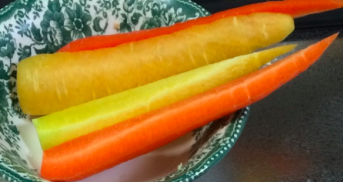
Step 4: Cut vegetables into pieces that are ⅛ to ½ inches thick. The pieces will shrink as they dry. Those vegetables higher in water content will shrink more, therefore, make thicker slices of those vegetables. It is important to keep sizes uniform, so they dry at the same rate.
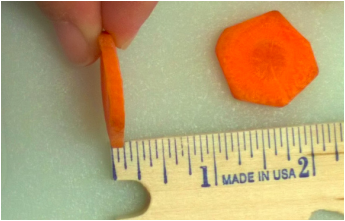
Step 5: Pretreat vegetables by blanching. Blanching is a cooking technique that includes briefly boiling or steaming vegetables. It slows or stops the enzyme activity that would otherwise cause unwanted changes in color and flavor to the vegetables during drying. Blanching also enhances the destruction of potentially harmful bacteria during drying vegetables.4 Not all vegetables need blanching, and the length of blanching time varies with the vegetable. Over blanching causes loss of flavor and color.
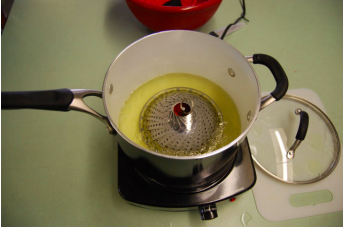
Blanching -
a. Fill a large pot ⅔ full of water and bring it to boil. b. Put vegetables into a colander (wire basket, coarse mesh bag, or metal strainer) and place them into the boiling water. c. Cover the pot. Set a timer once the water returns to boil. If it takes more than 1 minute to return to boil, reduce the number of vegetables that you are putting in at a time.
Step 6: Cool and dry the prepared vegetables. At the end of blanching, place the vegetables in ice water or cold running water to stop the blanching process. When they are warm to touch, drain well and blot the pieces dry on a paper towel to remove excess moisture. Save the water for immediate use in cooking. You can use it in soups and stews in place of vegetable or chicken stock. It will add flavor and some vitamins and minerals to your soups, stews, and gravies.
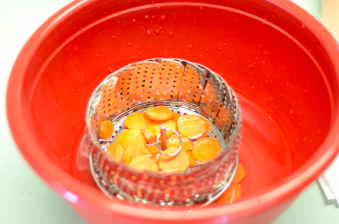

Step 7: Drying vegetables in the dehydrator.
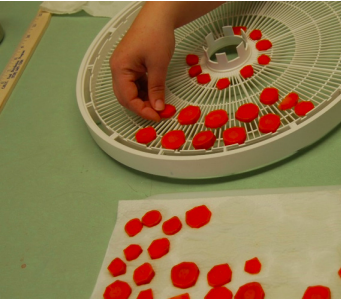
a. Once the pieces have been dried from blanching, they are ready to place on the dehydrator trays. Place the vegetable pieces on trays in a single layer. Avoid overfilling or overlapping.
b. Place the dehydrator in a well-ventilated room. c. Preheat the dehydrator to 125°F-140°F. For best results, follow the directions that came with your dehydrator.
Step 8: Package and store dried vegetables.
Tips for packaging dried vegetables:
• Package dried vegetables only after are completely cooled. Warm dried vegetables will hold some moisture, which is then released when it cools.
• Package your dried vegetables in clean, dry, dark glass jars, air-tight containers or freezer bags. If you are using freezer bags, be sure to remove all air from the bags.
• Pack dried vegetables in amounts that can be used all in a recipe at once.
• Label each container with the name of the vegetable and the date it was packaged.
Tips for storage of dried vegetables
• Store containers in a cool, dry and dark area. A temperature of 60 degrees is best to store dried vegetables. Acceptable storage temperatures range from 60 to 80 degrees.
• Dried vegetables can be stored for up to six months. Always label your containers with the date you dried the product. You can also put a use-by date to ensure you use the product.
• To extend the shelf-life of dried vegetables, store them in the refrigerator or freezer.
• Check dried vegetables during storage to ensure they stay dry. Discard dried vegetables that develop mold.
In addition to being a delicious, healthy snack, dried vegetables provide convenient, economical and delicious addition to meals.
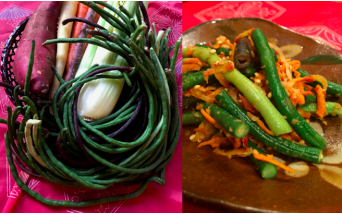
An easy way to use dried vegetables is by adding them to a soup, stew, casserole or sauce.
Do not over-soak the vegetables, because it produces less flavor and loss of texture.
Leafy vegetables and tomatoes do not need to be soaked.
Don’t toss the soaking liquid. You can use it immediately for cooking, as it contains nutrients and flavor.
For a full list of steps, and dehydrators, click here.
